| کد مقاله | کد نشریه | سال انتشار | مقاله انگلیسی | نسخه تمام متن |
|---|---|---|---|---|
| 7104329 | 1460339 | 2018 | 10 صفحه PDF | دانلود رایگان |
عنوان انگلیسی مقاله ISI
Glucose-insulin model identified in free-living conditions for hypoglycaemia prevention
ترجمه فارسی عنوان
مدل گلوکز-انسولین در شرایط آزاد زندگی برای پیشگیری از هیپوگلیسمی شناسایی شده است
دانلود مقاله + سفارش ترجمه
دانلود مقاله ISI انگلیسی
رایگان برای ایرانیان
کلمات کلیدی
موضوعات مرتبط
مهندسی و علوم پایه
مهندسی شیمی
تکنولوژی و شیمی فرآیندی
چکیده انگلیسی
Hypoglycaemia avoidance is one of the main barriers to the optimal management of Type 1 Diabetes (T1D). In order to attenuate the effect of hypoglycaemia, alarm systems support T1D subjects equipped with Continuous Glucose Monitoring (CGM) devices. The development of predictive detection tools for hypoglycaemia and CGM have been accelerated by Artificial Pancreas (AP), a closed-loop systems for automatic blood glucose control in T1D subjects. The methods to generate hypoglycaemia alarms can be divided in two categories: low-threshold detection and prediction. The first notifies the crossing of a critical blood glucose level, while the second predicts this risk in advance and it is typically based on a patient model. Considering the significant inter-patient variability characterizing T1D subjects, patient-tailored models are required. In this regard, different individualization techniques have been proposed showing significant improvements compared to “average” models. This paper proposes an alarm system based on patient-tailored models obtained through an identification technique that exploits impulse response data collected in silico and that is extended here to be used on free-living data. In particular, the data used in this work derive from a 1 month AP trial performed in free-living conditions. Individualized models obtained with different identification parameters are compared. Independently of the selected parameters, the patient-tailored models show superior predictive performance with respect to the “average” model used in the Model Predictive Control (MPC) algorithm used in the trial. The best model is used to design an alarm system which shows significant improvements in hypoglycaemia detection in comparison with the safety system used in the trial: true positive are increased by 31% with a decrease of the false positive by 57%. The promising prediction capabilities of the proposed patient-tailored models can be a key ingredient for a new generation of individualised MPC for AP.
ناشر
Database: Elsevier - ScienceDirect (ساینس دایرکت)
Journal: Journal of Process Control - Volume 64, April 2018, Pages 27-36
Journal: Journal of Process Control - Volume 64, April 2018, Pages 27-36
نویسندگان
C. Toffanin, S. Del Favero, E.M. Aiello, M. Messori, C. Cobelli, L. Magni,
